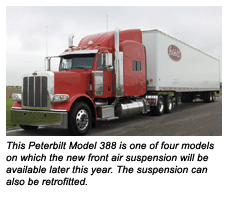Test drive of Peterbilt’s new front air suspension
Recently, I was invited to get “up close and personal” with a new proprietary front leaf suspension system developed by Peterbilt Motors Co. I spent the better part of a day at the company’s facility in Denton, Texas, learning about the design and manufacturing process –– and –– had a chance not only to test-design one of the suspension’s components, but also participate in a test drive of the new suspension mounted on a Peterbilt Model 388.

According to the company, this new generation front suspension has an innovative design, advanced technology and high performance components that deliver significant improvements in ride comfort. This is great news for fleets looking to improve tire wear, better protect cargo and provide a quieter, more comfortable ride for drivers.
In conversations with Peterbilt research and design engineers, I learned that the group’s intent was to design a suspension that had a more car-like ride. In addition, the team wanted to provide a lighter weight solution for its customers. The front air suspension is available on both of its traditional trucks –– the Model 389 and Model 388 –– as well as two of Peterbilt’s aero products, the Model 386 and Model 384.
Design specifics
The front air leaf design uses four air springs to support 75 percent of the sprung load. Unique to this design, the front spring has a long, lower leaf with a low spring rate for better isolation of road inputs –– and a shorter, stiffer, upper leaf for improved roll stability and handling. As a result, the new front air leaf gives a 20 percent improvement in ride, while at the same time having roll stiffness and handling equivalent to a taper leaf suspension.
To meet the lighter weight parameters desired by on-highway customers, the truck maker is also making the product available in an aluminum casting. For off-highway units, the suspension is made of iron and steel. Both versions of the front leaf suspension are completely retrofittable.
The new system is designed to reduce road inputs to the cab, chassis and powertrain, which helps extend component life. It was also designed with the new FMVSS 121 braking stopping distances in mind, which may require air disk brakes for some applications. In addition, it has maintenance-free rubber bushed spring pins and bonded one-piece shock absorber bushings. The barrel lock and latch air spring design simplifies service.
To demonstrate the simplified service, Peterbilt engineers allowed me to do a quick install of one of the air bags. It took just seconds to seat and latch the bottom section of the air bag assembly to the mount positioned on the frame, and a couple more seconds to inflate it. If I can do this quickly and easily, anyone can.
Field tests
Peterbilt currently has the new front leaf spring running on fleets in Mexico up to the 1.5 million mile mark. The mileage is being tracked and verified via GPS. Mexico was chosen as a test site because of its more severe road conditions. In addition, the company will test the product an additional 2.3 million miles in the lab. The suspension will be ready for full production later this year.
On the road
After the fact-finding portion of my day, I took to the road with Project Engineer, Steve Polansky and Technical Lab Manager, John Myers. We climbed into a new Peterbilt Model 388 70-in. sleeper cab, which had the new front air leaf suspension (the very one on which I had installed one of the air bags earlier in the day) and set off to validate the ride performance using a laptop computer with proprietary software connected to vibration sensors mounted on the cab. The tractor was pulling a 53-ft. trailer, with a combined tractor/trailer weight of 65,000 lbs. There was a 550 HP Cummins ISX under the hood.
At specific mileposts along I-35 outside Denton, we tracked hundreds data points every second to note movement and vibration. This demonstration was an example of the performance testing that goes into the extensive design process for components developed for the Peterbilt product line. While the laptop noted the ride on both smooth and bumpy roads, I noted the quiet ride and seemingly effortless movement under full load.
As we drove, Polansky monitored gradients of movement as multi-colored bars rose and dipped on the laptop screen. He noted that this type of testing helps the truck maker improve designs that give optimum ride.
After a day in the lab getting a hands-on introduction to product designs and installation –– and time on the road experiencing the improved ride of the new front air suspension –– I can attest to the fact that Peterbilt has been successful in developing an innovative new heavy-duty front air suspension.


